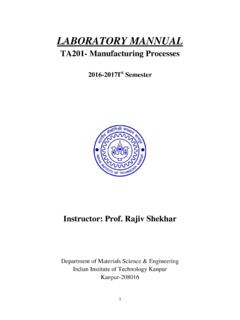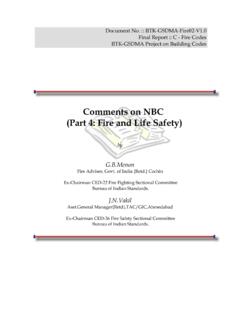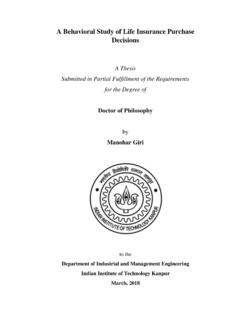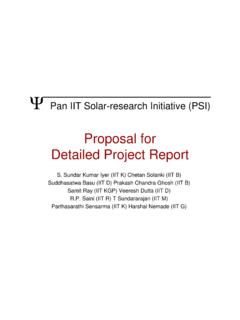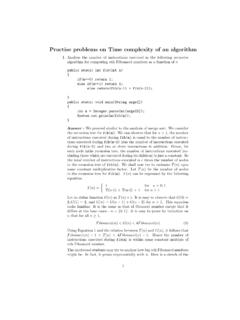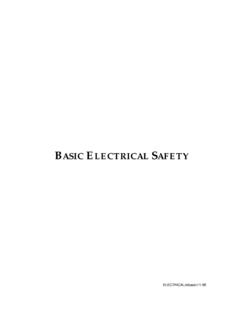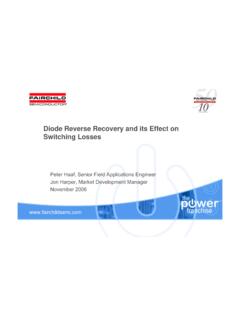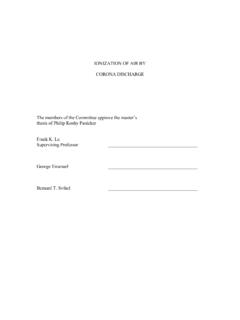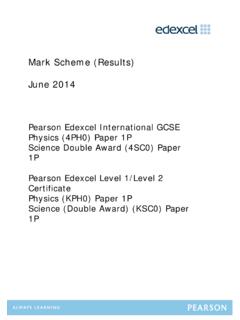Transcription of Concepts, Instrumentation and Techniques in ... - IIT Kanpur
1 Concepts, Instrumentation andTechniques in AtomicAbsorption SpectrophotometryRichard D. BeatyandJack D. KerberSecond EditionTHE PERKIN-ELMER CORPORATIONC opyright 1993 by The Perkin-Elmer Corporation, Norwalk, CT, Allrights reserved. Printed in the United States of America. No part of this publicationmay be reproduced, stored in a retrieval system, or transmitted, in any form or byany means, electronic, mechanical, photocopying, recording, or otherwise, with-out the prior written permission of the THE AUTHORSR ichard D. BeatySince receiving his degree in chemistry from the University of Missouri-Rolla, Richard Beaty has maintained an increasing involvement in the field oflaboratory Instrumentation and computerization. In 1972, he joined Perkin-Elmer,where he held a variety of technical support and marketing positions in atomicspectroscopy.
2 In 1986, he founded Telecation Associates, a consulting companywhose mission was to provide formalized training and problem solving for theanalytical laboratory. He later became President and Chief Executive Officer ofTelecation, Inc., a company providing PC-based software for laboratory automat-ion and D. KerberJack Kerber is a graduate of the Massachusetts Institute of Technology. He hasbeen actively involved with atomic spectrometry since 1963. In 1965 he becamePerkin-Elmer s first field Product Specialist in atomic absorption, supporting ana-lysts in the western United States and Canada. Since relocating to Perkin-Elmer scorporate headquarters in 1969, he has held a variety of marketing support andsales and product management positions. He is currently Director of Atomic Ab-sorption Marketing for North and Latin authors gratefully acknowledge the contributions and assistance they have re-ceived from their colleagues in preparing this book.
3 We are particularly indebtedto Glen Carnrick, Frank Fernandez, John McCaffrey, Susan McIntosh, CharlesSchneider and Jane Sebestyen of The Perkin-Elmer Corporation for the hours theyspent proofreading the several revisions and to Jorn Baasner, Horst Schulze, Ger-hard Schlemmer, Werner Schrader and Ian Shuttler of BodenseewerkPerkin-Elmer GmbH for their invaluable input on Zeeman-effect background cor-rection and graphite furnace atomic absorption Techniques . ivTABLE OF CONTENTS1 Theoretical Concepts and Definitions The Atom and Atomic Spectroscopy .. 1-1 Atomic Absorption Process .. 1-3 Quantitative Analysis by Atomic Absorption .. 1-4 Characteristic Concentration and Detection Limits .. 1-6 Characteristic Concentration .. 1-7 Detection Limits .. 1-72 Atomic Absorption InstrumentationThe Basic Components .. 2-1 AA Light Sources.
4 2-2 The Hollow Cathode Lamp .. 2-3 The Electrodeless Discharge Lamp .. 2-6 Optical ConsiderationsPhotometers .. 2-7 Single-beam Photometers .. 2-7 Double-beam Photometers .. 2-8 Alternative Photometer Designs .. 2-9 Optics and the Monochromator System .. 2-10 The Atomic Absorption AtomizerPre-mix Burner System .. 2-14 Impact Devices .. 2-15 Nebulizers, Burner Heads and Mounting Systems .. 2-16 ElectronicsPrecision in Atomic Absorption Measurements .. 2-17 Calibration of the Spectrometer .. 2-18 Automation of Atomic AbsorptionAutomated Instruments and Sample Changers .. 2-19 Automated Sample Preparation .. 2-20 The Stand-alone Computer and Atomic Absorption .. 2-203 Control of Analytical InterferencesThe Flame Process .. 3-1 Nonspectral Interferences .. 3-3 Matrix Interference .. 3-3 Method of Standard Additions .. 3-4 Chemical Interference.
5 3-5v3 Control of Analytical Interferences (continued)Ionization Interference .. 3-6 Spectral InterferencesBackground Absorption .. 3-7 Continuum Source Background Correction .. 3-8 Introduction to Zeeman Background Correction .. 3-11 Other Spectral Interferences .. 3-14 Interference Summary .. 3-144 High Sensitivity Sampling SystemsLimitations to Flame AA Sensitivity .. 4-1 The Cold Vapor Mercury TechniquePrinciple .. 4-2 Advantages of the Cold Vapor Technique .. 4-2 Limitations of the Cold Vapor Technique .. 4-3 The Hydride Generation TechniquePrinciple .. 4-3 Advantages of the Hydride Technique .. 4-4 Disadvantages of the Hydride Technique .. 4-4 Graphite Furnace Atomic AbsorptionPrinciple .. 4-5 Advantages of the Graphite Furnace Technique .. 4-55 Introduction to Graphite Furnace Atomic AbsorptionConsiderations in Ultra Trace AnalysisPerformance Criteria.
6 5-1 Graphite Furnace Applications .. 5-2 Components of the Graphite Furnace SystemThe Graphite Furnace Atomizer .. 5-2 The Graphite Furnace power Supply and Programmer .. 5-5 Summary of a Graphite Furnace Analysis .. 5-5 Sample Size .. 5-6 The Drying Step .. 5-7 The Pyrolysis Step .. 5-8 The Pre-atomization Cool Down Step .. 5-8 The Atomization Step .. 5-8 The Clean Out and Cool Down Step .. 5-9 Fast Furnace Analysis .. 5-9vi5 Introduction to Graphite Furnace Atomic Absorption (continued)Measuring the Graphite Furnace AA SignalNature of the Graphite Furnace Signal .. 5-10 Peak Height Measurement .. 5-10 Peak Area Measurement .. 5-11 Solid Sampling With the Graphite Furnace .. 5-126 Control of Graphite Furnace InterferencesInterferences and the Graphite Furnace .. 6-1 Spectral InterferencesEmission Interference .. 6-2 Background Absorption.
7 6-3 Background Reduction Techniques .. 6-3 Automated Instrumental Background Correction .. 6-6 Interpolated Background Correction .. 6-6 Nonspectral InterferencesDefinition .. 6-8 Method of Standard Additions .. 6-8 The Graphite Tube Surface .. 6-9 The L vov Platform .. 6-10 Matrix Modification .. 6-11 Maximum power Atomization .. 6-12 Peak Area Measurement .. 6-13 Fast Electronics and Baseline Offset Correction .. 6-14 Stabilized Temperature Platform Furnace The Goals .. 6-15 The STPF System .. 6-157 Alternate Analytical TechniquesDirect Current Plasma (DCP) Emission .. 7-1 Inductively Coupled Plasma (ICP) Emission .. 7-2 Inductively Coupled Plasma-Mass Spectrometry (ICP-MS) .. 7-3 Summary .. 7-4vii1 THEORETICAL CONCEPTS AND DEFINITIONSTHE ATOM AND ATOMIC SPECTROSCOPYThe science of atomic spectroscopy has yielded three Techniques for analyticaluse: atomic emission, atomic absorption, and atomic fluorescence.
8 In order to un-derstand the relationship of these Techniques to each other, it is necessary to havean understanding of the atom itself and of the atomic process involved in atom is made up of a nucleus surrounded by electrons. Every element has aspecific number of electrons which are associated with the atomic nucleus in anorbital structure which is unique to each element. The electrons occupy orbital po-sitions in an orderly and predictable way. The lowest energy, most stable electronicconfiguration of an atom, known as the ground state , is the normal orbital con-figuration for an atom. If energy of the right magnitude is applied to an atom, theenergy will be absorbed by the atom, and an outer electron will be promoted to aless stable configuration or excited state . As this state is unstable, the atom willimmediately and spontaneously return to its ground state configuration.
9 The elec-tron will return to its initial, stable orbital position, and radiant energy equivalentto the amount of energy initially absorbed in the excitation process will be process is illustrated in Figure 1-1. Note that in Step 1 of the process, the ex-citation is forced by supplying energy. The decay process in Step 2, involving theemission of light, occurs 1-1. Excitation and decay wavelength of the emitted radiant energy is directly related to the electronictransition which has occurred. Since every element has a unique electronic struc-ture, the wavelength of light emitted is a unique property of each individual ele-ment. As the orbital configuration of a large atom may be complex, there are manyelectronic transitions which can occur, each transition resulting in the emission ofa characteristic wavelength of light, as illustrated in Figure process of excitation and decay to the ground state is involved in all threefields of atomic spectroscopy.
10 Either the energy absorbed in the excitation processor the energy emitted in the decay process is measured and used for analytical pur-poses. In atomic emission, a sample is subjected to a high energy, thermal envi-ronment in order to produce excited state atoms, capable of emitting light. Theenergy source can be an electrical arc, a flame, or more recently, a plasma. Theemission spectrum of an element exposed to such an energy source consists of acollection of the allowable emission wavelengths, commonly called emissionlines, because of the discrete nature of the emitted wavelengths. This emissionspectrum can be used as a unique characteristic for qualitative identification of theelement. Atomic emission using electrical arcs has been widely used in Techniques can also be used to determine how much of an element is pre-sent in a sample.

